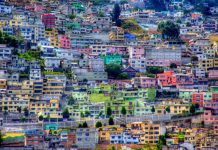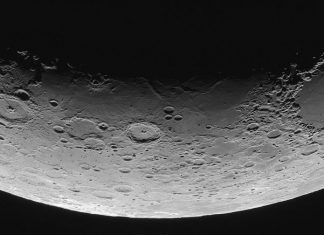Sacred Centre Today there is little doubt that Tiahuanaco (also called Tiwanaku).was a major ceremonial centre and focal point of a culture that spread across much of the region. The ancient people built a pyramid of crude stones known as the Akapana
Gateway of the Sun, Tiahuanaco
Entrance to Kalasayaya temple, Tiahuanaco, Bolivia
That structure dominates the bottom half of this aerial photo.
When first recorded the pyramid was largely covered with earth. After several decades of excavation some of the walls have been uncovered and treasure hunters opened a depression in the top. This was built originally to open towards the east. The dark line across the lower part of the picture is the railway line from a lakeside port to La Paz, the Bolivian capital. The rectangular outline just ‘above and to the left ‘ of the Akapana is a terreplein. known as the Kalasasaya. The lighter patch with an indistinct outline ‘above’ the Akapana is where an excavated semi-subterranean ‘temple’ has been discovered. Other features are visible but most of the ‘patches’ are fields. The upper part of the picture is crossed by the road from the the village of Tiwanaku leading eastwards to La Paz. (taken from ‘Pathways to the Gods’ by Tony Morrison 1978).
Pumapunku (Puma Punka)
Just out of the picture (above) to the bottom left is the site of the Puma Punku.
This is another ‘temple area’ with many finely cut stones some weighing over 100 tonnes. Its position to the south of the Akapana may have been important because it gave a good view to a sacred mountain far to the east. Of course there is no certainty that this was the reason as the ancient builders left no written records.
All the legends have been handed down through the generations.
Puma Punku ruins, Tiahuanaco, Bolivia
Puma Punku, truly startles the imagination. It seems to be the remains of a great wharf (for Lake Titicaca long ago lapped upon the shores of Tiahuanaco) and a massive, four-part, now collapsed building. One of the construction blocks from which the pier was fashioned weighs an estimated 440 tons (equal to nearly 600 full-size cars) and several other blocks laying about are between 100 and 150 tons. The quarry for these giant blocks was on the western shore of Titicaca, some ten miles away. There is no known technology in all the ancient world that could have transported stones of such massive weight and size. The Andean people of 500 AD, with their simple reed boats, could certainly not have moved them. Even today, with all the modern advances in engineering and mathematics, we could not fashion such a structure.
Carved stone block at Puma Punku. This precision-made 6 mm wide
groove contains equidistant, drilled holes. It seems impossible that this
cuts were made with use of stone or copper tools.
How were these monstrous stones moved and what was their purpose? Posnansky suggested an answer, based upon his studies of the astronomical alignments of Tiahuanaco, but that answer is considered so controversial, even impossible, that it has been ignored and censured by the scientific community for fifty years.
MYTHOLOGY – HISTORY
The ruins of Tiahuanaco city and centre of worship are located on the Altiplano in today’s Bolivia, ca 4000 m from water level, and 21 km north-east from Lake Titicaca. Tiahuanaco was a capital of a theocratic state governed by priest kings. The state exerted its influence on the development of the whole southern part of Peru in the closing centuries of the last millennium, expanding its influence in a peaceful manner on the vast highland as well as coastal territory.
Tiahuanaco, therefore, carried out a pacifistic cultural mission quite different from that of its contemporary militant country of Huari (Wari) in the Peruvian Andes. The religious sources of this period are first and foremost archaeological findings, but to a great extent also the recordings of the 16th century chroniclers.
The religion of Tiahuanaco centred around the cult of a sky and thunder god Viracocha. The deity was generally depicted as having staves in both of his hands and an aureole around his head. The aureole suggests the qualities of a sun god, represented on the bas-relief in the upper part of the famous Sun Gate in Tiahuanaco as well as on ceramic.
The staves, on the other hand, suggest Viracocha’s distant ancestry from the nearly thousand years older Chavín sky god in North Peru. His attendants were ranking deities in the shapes of cougar, condor, falcon and snake. Viracocha was worshipped as the main god in Huari as well; there his characteristics were apparently more militant. A head of Tiahuanaco state functioned both as a king and the arch-priest and he was revered as Viracocha’s embodiment on earth (Kelm 1990: 524-528).
The chronicle records describe the citizens of Tiahuanaco as «the Viracochas», who were fair-skinned and wore white long robes. Viracocha is also described as a man with fair skin and white beard, attired in a long robe and sandals, wearing a staff, with a cougar lying at his feet. He was a kind and peace-loving god who had also subjected the dreadful jaguar-god to his power.
The idea might refer to the Tiahuanaco’s peaceful mission among the distant warrior cultures of Peru. According to the legend, however, evil people in short clothes came to the sacred lake and forced Viracocha to leave to north. On his departure they mocked and taunted him for his long robe and lenient disposition. Eventually, he had descended from the highlands to the coast and left over the ocean, promising to return some day
In 1921 one of the leading researchers of Peruvian cultures from the first part of this century José de la Riva Agüero y Osma, who had also studied the chronicle records as well as linguistic and archaeological data for nearly 25 years, published his «theory of the paleo-Quechuan empire».
The theory focused on the hypothesis that Tiahuanaco was originally the cradle and home of the Inca Empire, and the Inca themselves the upper class of the once emigrated Tiahuanaco people. He also argued that the Quechuans, Aymarans and Araucanians had to originate from the same ancient and anthropologically close ancestral nation who spoke a language related to theirs, and was developed to a degree that could influence them, the younger peoples. Riva-Agüero’s term for such ancestors was ‘paleo-Quechuans’ (Busto I s.a.: 186-194).
Even today the Aymarans inhabit the surroundings of Lake Titicaca. They have preserved heritage on their ancient migration and the subjugation of the town people who were driven from the city. Also, the archaeological data supports the idea of the late arrival of the Aymarans. Riva-Agüero speculates that the paleo-Quechuans were now forced to leave among other places for the Cuzco Valley, the later settlement of the Inca.
A chronicler informs us that the first king of the Inca Manco Capac came from Tiahuanaco (Vega 1988: 34-37). We also know that the relationship between the Quechuans and the Aymarans could be characterised by a constant feud which might have been caused by the fugitives’ anger towards the invaders.
Agüero also argues that the affinity of the Quechuan and Aymaran languages is due to the existence of a common primal language, possibly the paleo-Quechuan. The archaeological data also confirms the Aymaran immigration.
The chullpa’s, or the burial towers around Titicaca belonged supposedly to the Aymarans; still, the earliest settlers of Tiahuanaco mummified their dead similarly to the Inca, similarities could be found also between the pottery from the golden age of Tiahuanaco and that of the Inca – the ceramic ware of Aymarans is considerably different.
The clothing of the Aymarans differed as well, being shorter than the Quechuan dress, which once again supports the legend about the departure of the long-robed Tiahuanacos.
Montesinos, the chronicler, informs us that the priest kings of Tiahuanaco, or los amautas as they were called, fled the country trying to save the cult of their own gods (Busto I s.a.: 191). This is another evidence proving that the Inca originated from the upper class who were forced to leave Tiahuanaco by the militant Aymarans, or los piruas.
The idea of the Inca having been militant aroused from the new circumstances.
The Inca regarded the surroundings of Titicaca as their former home and revered Viracocha as a god who had told them to build the city of Cuzco. Later, the mythology related to Viracocha acquired an important role in the Inca religion.
Thus, we might reason that the founders of the Tiahuanaco culture were the common ancestors of the Quechuans and Aymarans, i.e. the paleo-Quechuans. Presumably, the militant Aymarans crushed Tiahuanaco in the 10th-11th century and forced the majority of the upper class flee northward to the mountain valleys inhabited by other Quechuan kin tribes.
The Aymarans could not destroy the powerful civilisation all at once and founded the kingdom of Colla, which in the 15th century was incorporated into the state of the same Inca who were once driven from their homeland by the Collas. Thus, the hypothesis of Riva-Agüero expanded to a theory which is acknowledged by most of the historians in Peru.
Consequently, the Inca were the genetic and cultural successors of the Tiahuanaco people. According to the archaeological data these Quechuan emigrants arrived at their kin tribes in the Cuzco Valley at the beginning of the 12th century and founded their city-state on the spot.
Since 1538 the Inca ruler Pachacutek Yupanqui employed the necessity of defeating the militant Chancas, subjugated other Quechuan city-states and merged them into the empire that reigned the whole of Peru, northern Chile, northern Bolivia and southern Ecuador until the invasion of Spanish conquistadors.
The archaeological material for the religion of this period is abundant, and can be compared to the detailed accounts of the 16th-17th century Spanish chronicles (Kauffmann Doig 1991: 78).
The highest ranking deity of the Inca was a celestial supreme being who was first known under the name Viracocha, later also as Pachacamak. Originally, Pachacamak was a sky god of the Lurín Valley in central Peru whose name was later given to the sky god of the Inca.
The main god of the Inca state religion was the sun god Inti, who might have been a nature totem of the Quechua or a god of a certain tribe. Another significant deity in the Inca pantheon was the thunder god Illapu who was apparently distinctive from the Tiahuanaco sky god, but was named after a thunder god of the central Peruvian tribes.
Viracocha became the culture hero of the Inca who was said to have brought culture to people, then set off to the Pacific and promised to return. (Kulmar 1999: 101-109).
The Inca myths can be divided in two groups:
- the creation myths
- the origin myths
Creation Myths
The world was created by Viracocha near Lake Titicaca. After the great deluge or the receding of chaotic floodwaters Viracocha descended to earth and created plants, animals and men to the empty land; he built the city of Tiahuanaco and appointed 4 world rulers of whom Manco Capak became the superior of the Ursa Major world, i.e. the north horizon (Busto II 1981: 7).
Origin Myths
Myths about the Ayar brothers
Four pairs of brothers-sisters created by Viracocha to rule the world left the cave of Mountain Pacaritambo. The whole world was living in an uncivilised and ignorant manner. The newcomers began with organising the mankind and divided people into ten large communities.
Leading the tribes the brothers set off in search of enough fertile land to sustain themselves. They carried Sunturpaucar, a long staff adorned with colourful feathers, a cage with a sun-bird who could give good advice and other sacred objects in front of them.
Making shorter and longer stops they moved towards Cuzco. In the course of the long journey the group became smaller: the rivalling brothers confined one of their companions to a cave, two others wished to break away but were turned into stones. The only surviving brother Ayar Manco a.k.a. Manco Capak accompanied by his sister and wife Mama Ocllo and his brothers’ wives, founded the city of World Pole in the name of Viracocha the Creator and Inti the Sun God, and settled there with his people.
A myth of Manco Capak and Mama Ocllo
A long time ago when the world was filled with savages, misery and poverty, a brother and a sister, a married couple Manco Capak and Mama Ocllo left Lake Titicaca. Inti, the sun god had sent them to refine the surrounding peoples, and gave them a golden stick for testing the land for cultivation and then settling in the suitable place.
Having found such a place they had to found the state, teach the people how to live proper lives and advocate the worship of the sun god. The journey took a long time. Eventually, in the Cuzco Valley the golden stick disappeared into the ground, and they could start with their mission.
Manco Capak taught his people the cultivation and irrigation of land and handicraft, Mama Ocllo taught women spinning, weaving and sewing. The tribe of Manco Capak became to be called by the name of Hanan Cuzco (High Cuzco) and the relatives of Mama Ocllo by the name of Hurin Cuzco (Lower Cuzco).
































